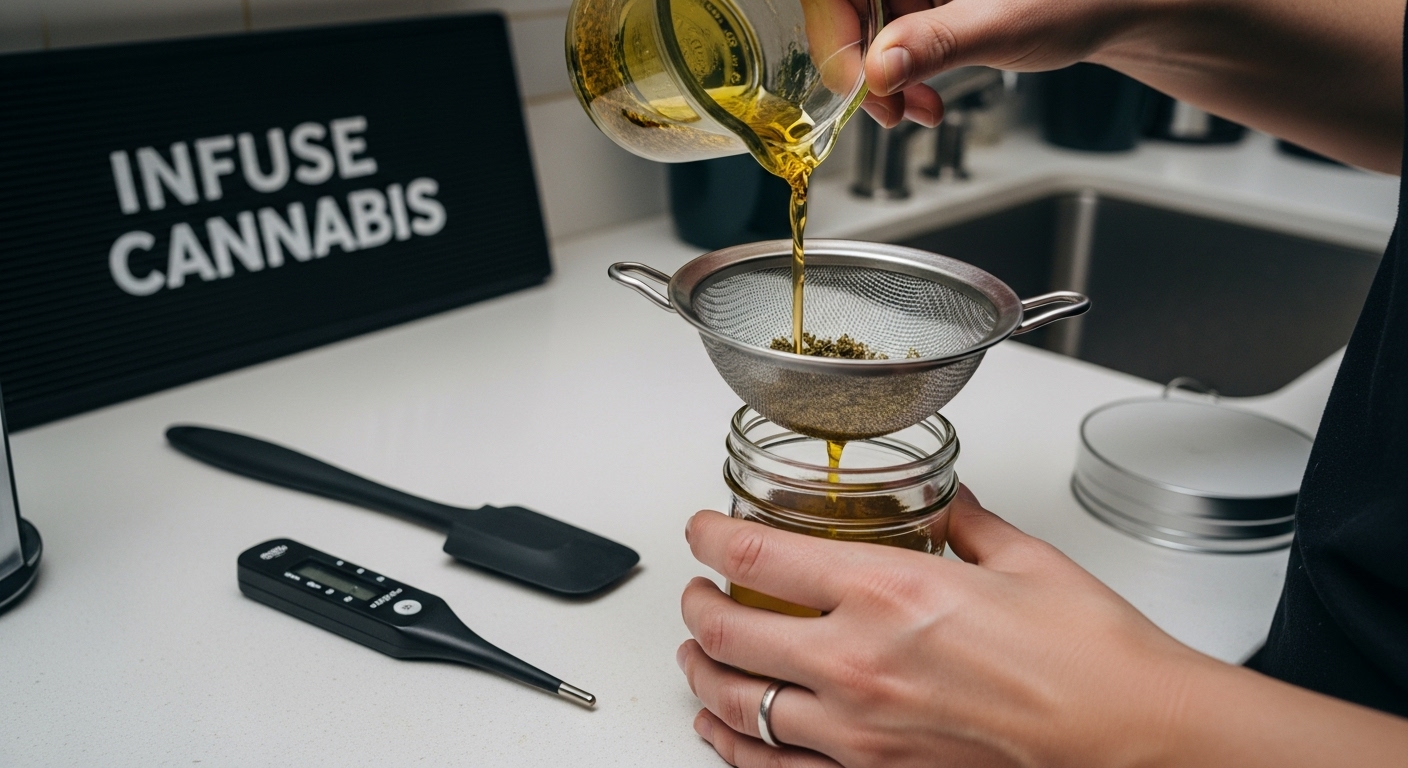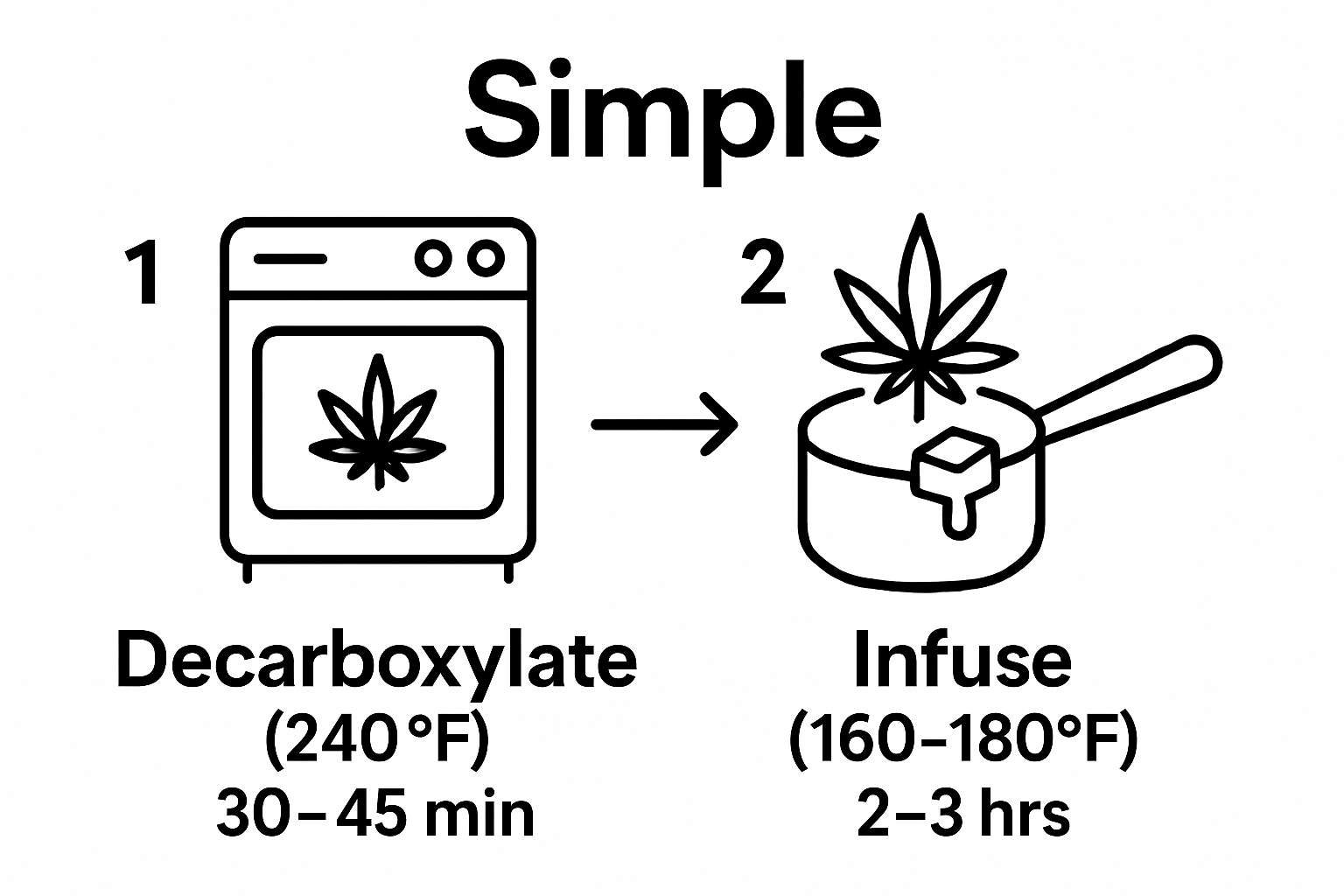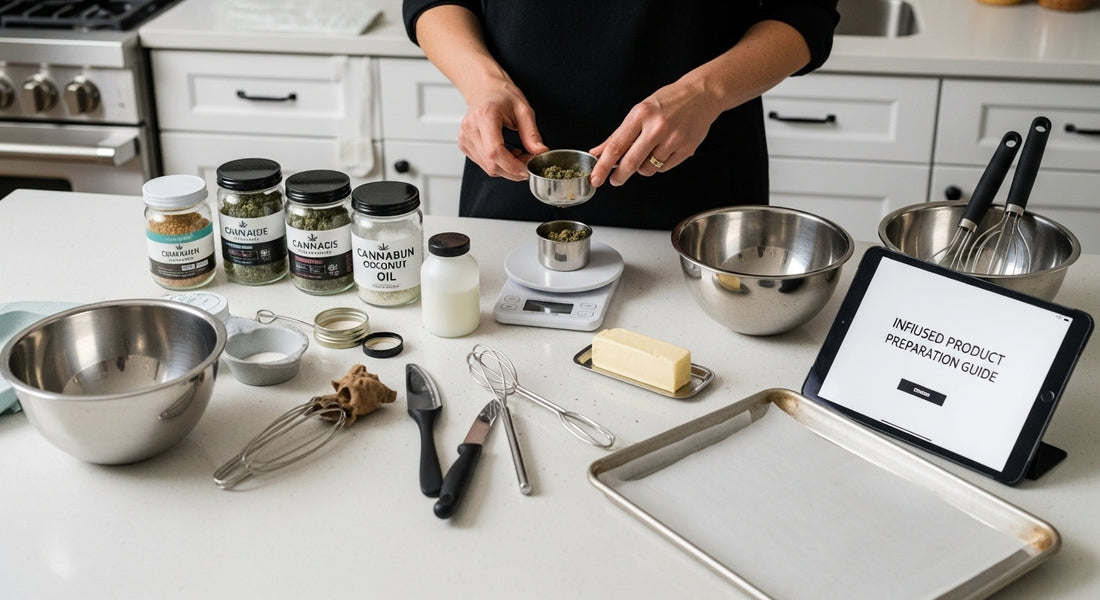Making your own cannabis edibles can seem tricky at first. There’s flavor, potency, even safety to worry about, and every step affects the final result. Yet most people don’t realize that choosing the right cannabis strain, with THC levels between 15 to 20 percent, makes all the difference in how your edibles taste and feel. Surprisingly, the secret to great edibles starts long before you even turn on the oven.
Table of Contents
- Step 1: Select The Right Cannabis Strain
- Step 2: Gather Necessary Equipment And Ingredients
- Step 3: Decarboxylate Your Cannabis For Maximum Potency
- Step 4: Infuse Cannabis Into Your Chosen Medium
- Step 5: Create And Customize Your Final Product
- Step 6: Test And Store Your Infused Product Properly
Quick Summary
| Key Point | Explanation |
|---|---|
| 1. Choose the Right Strain | Select a cannabis strain based on cannabinoid profiles to achieve desired effects and flavors. |
| 2. Use Proper Equipment | Invest in high-quality kitchen tools to ensure safety, consistency, and optimal infusion results. |
| 3. Decarboxylate for Potency | Properly activate cannabis before infusion to harness its full psychoactive properties. |
| 4. Infuse with Care | Maintain precise temperatures during infusion for effective cannabinoid extraction without degradation. |
| 5. Test and Store Correctly | Carefully dose and store infused products in airtight, light-protective containers to ensure potency and safety. |
Step 1: Select the Right Cannabis Strain
Selecting the right cannabis strain is the foundational step in crafting premium infused products. Your strain choice directly impacts flavor, potency, and overall experience. Understanding strain characteristics becomes crucial for creating exceptional edibles that deliver consistent and targeted effects.
Start by examining the cannabinoid profile of potential strains. Cannabis varieties contain different ratios of THC and CBD, which dramatically influence the final product’s therapeutic and recreational qualities. Indica strains typically offer more relaxing properties, while sativa strains provide energizing effects. Explore our guide on cannabis strain selection to understand nuanced differences.
Consider your specific objectives when choosing a strain. Medical users might prioritize high CBD content for pain management, whereas recreational consumers could seek balanced THC levels for mild euphoria. Hybrid strains offer versatile options, blending characteristics from both indica and sativa genetics. Evaluate key factors like terpene composition, which contributes to aroma and potential mood enhancement.
Quality matters immensely in strain selection. Look for lab tested cannabis with transparent Certificate of Analysis documentation. Reputable sources provide detailed cannabinoid percentages, ensuring you understand precisely what you’re incorporating into your infused products. Fresh, properly cured cannabis delivers superior flavor profiles and more consistent infusion results.
Practical tip: Begin with strains containing moderate THC levels between 15 20 percent for balanced edible experiences. Avoid extremely potent strains during initial experiments, as they can create overwhelming effects. Gradually experiment and document your findings to refine your infusion techniques and strain preferences.
Successful strain selection transforms your infused product from ordinary to extraordinary. Your careful consideration will directly translate into a more enjoyable and predictable cannabis experience.
The following table provides an overview of each major step in the infused product preparation process, summarizing the objective, estimated time, and key considerations for every stage.
| Step | Objective | Estimated Time | Key Consideration |
|---|---|---|---|
| Select the Right Cannabis Strain | Determine flavor, potency, and effects | 10-20 minutes | Choose tested, fresh cannabis |
| Gather Equipment and Ingredients | Assemble tools and key materials | 10-15 minutes | Ensure proper cleaning and readiness |
| Decarboxylate Cannabis | Activate THC and CBD for potency | 30-45 minutes | Maintain temp. (approx. 240°F) |
| Infuse into Chosen Medium | Extract cannabinoids into fats/oils | 2-3 hours | Temperature (160-180°F) critical |
| Create & Customize Final Product | Incorporate infusion into recipes | Varies (1-2 hours) | Careful dosage and even mixing |
| Test and Store Product Properly | Dose accurately and preserve potency | Ongoing | Airtight, opaque storage imperative |
Step 2: Gather Necessary Equipment and Ingredients
Preparing high quality cannabis infused products requires meticulous equipment selection and ingredient preparation. This crucial stage sets the foundation for successful infusion, ensuring safety, consistency, and optimal flavor profile. Proper preparation prevents potential complications and guarantees a smoother infusion process.
Below is a summary table of the essential equipment and ingredients needed for preparing premium cannabis-infused products, including their specification and primary purpose.
| Equipment / Ingredient | Specification | Purpose |
|---|---|---|
| Digital Scale | High accuracy, measures in grams | Calculate precise cannabis and ingredient amounts |
| Mixing Bowls | Stainless steel or glass | Chemical-neutral surface for safe ingredient mixing |
| Oven | Precise temperature control (up to 250°F) | Decarboxylating cannabis pre-infusion |
| Heat-Resistant Gloves | Insulated, food-grade | Protect hands during decarboxylation and infusion |
| Cheesecloth/Fine Mesh Strainer | Food-safe, fine weave | Filter plant material from infused medium |
| Airtight Storage Containers | Opaque, glass preferred | Protect and store finished infused products |
| High-Quality Fat (e.g. coconut oil, butter) | Organic, food-grade | Serves as the infusion medium for cannabinoids |
Your essential equipment toolkit should include precision measuring tools, food grade containers, and temperature controlled heating devices. Invest in a reliable digital scale capable of measuring grams with high accuracy, which becomes critical when calculating cannabinoid concentrations. Stainless steel or glass mixing bowls provide neutral surfaces that won’t interact chemically with your ingredients. Check our safety recommendations for edible preparation to understand comprehensive equipment guidelines.
Key ingredients demand careful selection and preparation. Choose high quality fats like coconut oil, butter, or neutral oils which effectively extract cannabinoids through their lipophilic properties. Organic ingredients minimize potential contaminant introduction and enhance overall product quality. Decarboxylation equipment such as an oven with precise temperature control becomes essential for activating cannabis compounds before infusion.
Safety equipment represents another critical consideration. Always have heat resistant gloves, silicone spatulas, and fine mesh strainers available. Cheesecloth or purpose built filtering materials help remove plant material during the extraction process, producing cleaner final products. Airtight storage containers protect your infused ingredients from oxidation and maintain potency.
Verify your equipment readiness by performing a pre production checklist. Ensure all tools are thoroughly cleaned and sanitized. Check temperature measurement devices for accuracy. Confirm you have backup supplies in case of unexpected challenges. Proper preparation transforms your infusion journey from potentially complicated to smoothly executable.
Remember that quality equipment represents an investment in your craft. Professional grade tools might seem expensive initially but deliver consistent results and enhance your ability to create premium cannabis infused products with confidence and precision.
Step 3: Decarboxylate Your Cannabis for Maximum Potency
Decarboxylation transforms raw cannabis from an inactive botanical material into a potent infusion ingredient by activating its primary cannabinoids. This chemical transformation is essential for creating edibles with predictable and desirable effects. Without proper decarboxylation, your cannabis will lack the psychoactive and therapeutic potential that makes infused products valuable.
The process requires precise temperature control and methodical execution. Preheat your oven to approximately 240 degrees Fahrenheit, a critical threshold for converting non psychoactive THCA into active THC. Learn more about cannabinoid activation to understand the scientific nuances of this transformation. Spread your ground cannabis evenly on a parchment lined baking sheet, ensuring consistent heat distribution. Break larger cannabis pieces into uniform small fragments to promote even decarboxylation.
Timing becomes crucial during this process. Most cannabis strains require 30 to 45 minutes of controlled heating to achieve optimal cannabinoid activation. Avoid temperatures exceeding 250 degrees Fahrenheit, which can potentially degrade valuable compounds and diminish product quality. Use an oven thermometer to verify accurate temperature maintenance, as built in oven readings can often be unreliable.
Recognize successful decarboxylation through visual and olfactory cues. Your cannabis should transform from a vibrant green to a more muted brownish green color. The material will appear slightly dry and emit a subtle, roasted herbal aroma. These indicators suggest that cannabinoid acids have been effectively converted into their active molecular forms, priming your cannabis for efficient infusion.
Professional tip: Consider using a dedicated toaster oven or specialized decarboxylation device for more consistent results. These tools offer more precise temperature control and minimize the risk of accidental overheating. Always work in a well ventilated space and use heat resistant gloves when handling hot cannabis materials.
Careful decarboxylation sets the stage for creating potent, predictable cannabis infused products. Your attention to detail during this step directly influences the final quality and effectiveness of your culinary cannabis creation.
Step 4: Infuse Cannabis into Your Chosen Medium
Infusion represents the transformative process where decarboxylated cannabis merges with fat based ingredients, extracting cannabinoids and creating a potent culinary foundation. Selecting the right infusion medium determines the final product’s flavor, potency, and overall effectiveness. Learn more about infusion techniques to understand nuanced extraction methods.
Fat serves as the ideal extraction vehicle due to its molecular compatibility with cannabinoids. Coconut oil emerges as a superior choice, offering high saturated fat content that efficiently captures THC and CBD compounds. Begin by combining your decarboxylated cannabis with the chosen medium in a precise 1:1 or 1:2 ratio, depending on desired potency. Use a double boiler or slow cooker to maintain consistent temperatures between 160 and 180 degrees Fahrenheit, which optimizes cannabinoid absorption without degrading sensitive compounds.
Constant monitoring becomes crucial during the infusion process. Stir the mixture periodically to prevent burning and ensure even heat distribution. The ideal infusion typically requires 2 to 3 hours of gentle heating, allowing cannabinoids to fully integrate with the fat molecules. Professional tip: Use a fine mesh strainer or cheesecloth to separate plant material from the infused medium, producing a clean, smooth final product.
Temperature control represents the most critical aspect of successful infusion. Temperatures exceeding 200 degrees Fahrenheit can break down valuable cannabinoids, reducing potency and altering the intended therapeutic effects. Invest in a reliable cooking thermometer to maintain precise heat levels throughout the extraction process. Slow, controlled heating prevents potential cannabinoid degradation and ensures maximum compound retention.
Verify successful infusion through visual and textural indicators. Your final infused medium should display a consistent color, typically ranging from golden to light brown, depending on the cannabis strain and fat used. The mixture should feel smooth and uniform, with no visible plant particulates. Allow the infused medium to cool completely before storing in an airtight container, protecting its potency and preventing oxidation.

Mastering the infusion technique transforms your cannabis from raw plant material into a versatile, potent culinary ingredient. Patience and precision during this stage guarantee a high quality, effective final product that meets your specific therapeutic or recreational objectives.

Step 5: Create and Customize Your Final Product
Customizing your cannabis infused product transforms technical preparation into a creative culinary experience. Precise measurement becomes paramount during this stage, ensuring consistent potency and predictable effects. Discover expert dosing techniques to refine your infusion skills and understand nuanced portioning.
Select a recipe that complements your infused medium, considering flavor profiles and desired cannabis effects. Baked goods like brownies or cookies offer straightforward incorporation, while more advanced preparations such as gourmet sauces or sophisticated confections provide complex flavor experiences. Calculate your total cannabinoid content by multiplying the percentage of THC in your original cannabis strain with the total weight of cannabis used during infusion.
When integrating your infused medium, mix thoroughly but gently to distribute cannabinoids evenly. Temperature control remains critical during this phase. Excessive heat can degrade THC, so incorporate your infused ingredient at lower temperatures. Professional bakers recommend adding cannabis infused oils or butter during later stages of recipe preparation to minimize potential compound degradation.
Dosage precision requires careful calculation and documentation. Start with conservative portions, typically 2.5 to 5 milligrams of THC per serving for beginners. Utilize a kitchen scale for accurate ingredient measurements and consider creating a detailed recipe log tracking strain, infusion details, and final product composition. This approach helps you reproduce successful recipes and understand your personal tolerance levels.
Final product verification involves multiple sensory and methodical checks. Visually inspect your edibles for uniform appearance and consistent texture. Taste test cautiously, recognizing that onset of effects can take 30 to 90 minutes. Label your creations clearly with total cannabinoid content and recommended serving sizes, prioritizing safety and responsible consumption.
Remember that crafting premium cannabis edibles is an art form requiring patience, precision, and continuous refinement. Each batch represents an opportunity to improve your technique, understanding both the scientific and creative dimensions of cannabis culinary preparation.
Step 6: Test and Store Your Infused Product Properly
Testing and storing cannabis infused products require meticulous attention to detail, ensuring both safety and potency preservation. Responsible consumption begins with careful evaluation of your meticulously crafted edibles. Learn more about cannabis beverage storage to enhance your understanding of product preservation techniques.
Initial testing demands a conservative and methodical approach. Start with a minimal dose, preferably 2.5 to 5 milligrams of THC, in a controlled environment with trusted companions. Wait at least 90 minutes to assess the full effect, recognizing that onset time varies based on metabolism, food intake, and individual biochemistry. Document your experience, noting onset time, intensity, duration, and any unexpected reactions. This personal log becomes invaluable for future dosage refinement.
Storage represents a critical phase in maintaining your infused product’s quality and potency. Choose airtight, opaque containers that protect against light, moisture, and temperature fluctuations. Glass containers with tight sealing mechanisms work exceptionally well for most infused products. Refrigeration can extend shelf life for products containing dairy or eggs, while shelf stable items like certain baked goods can be stored in cool, dark pantry environments.
Label your containers comprehensively, including crucial information such as total cannabinoid content, production date, and recommended serving size. Implement child resistant packaging and store products in locations inaccessible to minors or pets. Temperature consistency proves paramount temperature swings can degrade cannabinoids and alter product quality. Aim to maintain storage environments between 60 and 70 degrees Fahrenheit, avoiding direct sunlight and extreme temperature variations.
Professional tip: Consider vacuum sealing for long term storage, which minimizes oxidation and preserves cannabinoid integrity. Separate different potency levels and types of infused products to prevent accidental overconsumption. Use color coded or distinctly labeled containers to distinguish between various preparations.
Successful testing and storage transform your cannabis infused products from experimental creations to reliable, repeatable experiences. Your careful approach ensures not just personal satisfaction, but also promotes responsible and safe cannabis consumption.
Take Your Infused Edibles to the Next Level with Trusted Quality
Crafting premium cannabis edibles requires more than just precise preparation. This guide highlights how complex it can be to select the right strain, measure dosage accurately, and maintain consistent potency. A key pain point emerges when it comes to sourcing reliable cannabis ingredients. Without proper lab-tested products or transparent cannabinoid data, your results can be unpredictable and your experience less enjoyable.
Looking for a source you can trust for clean, potent cannabis? Start by exploring the wide selection of Pre Rolls on our site, each featuring thorough lab results to ensure you know exactly what you are using.

Visit Avondale Apothecary for top-tier cannabis strains, edibles, and accessories all in one place. Put your preparation skills to work using ingredients backed by verified transparency. Shop now and make your next batch of infused products safer, more enjoyable, and reliably potent.
Frequently Asked Questions
What is the importance of selecting the right cannabis strain for edibles?
Choosing the right cannabis strain is essential as it affects flavor, potency, and the overall experience of the edibles. Different strains have varying ratios of THC and CBD which can influence therapeutic and recreational qualities.
How do I decarboxylate cannabis properly for infusion?
To decarboxylate cannabis, preheat your oven to 240 degrees Fahrenheit, spread ground cannabis on a parchment-lined baking sheet, and heat for 30 to 45 minutes. This process activates the cannabinoids, making them effective for infusion.
What type of fat is best for infusing cannabis?
Coconut oil is often considered the best option due to its high saturated fat content, which efficiently extracts THC and CBD. Other fats like butter or neutral oils can also be used, but may not be as effective as coconut oil.
How should I store my cannabis-infused products for optimal freshness?
Store your cannabis-infused products in airtight, opaque containers to protect them from light, moisture, and temperature fluctuations. Refrigeration may be necessary for items containing dairy or eggs, while shelf-stable products can be kept in a cool, dark pantry.

